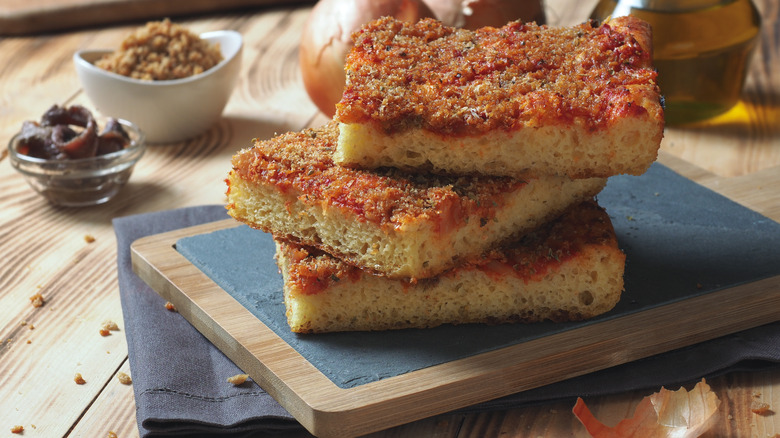The Difference Between Sicilian And Detroit-Style Pizza
Detroit-style and Sicilian pizza, while sharing a rectangular shape, differ significantly in terms of origins, toppings, and baking method. Detroit-style pizza hails from the Motor City and is renowned for its thick, crispy crust. What sets this pizza apart, though, is the Wisconsin brick cheese that is both mixed on top of the dough and layered on top of the crust.
The hallmark of Detroit-style pizza is the way this cheese extends on top of the crust from edge to edge, creating a caramelized cheese perimeter. Toppings, most popularly small cup pepperoni, are then placed on top of the cheese, and it's finished off with stripes of tomato sauce laid in what are known as "tire tracks" across the top.
Sicilian pizza, on the other hand, originates from Italy and its crust tends to be more dense and focaccia-like, where it's crispy on the outside and lighter on the inside. It's also a bit thinner than Detroit-style. Cheese and toppings typically go on top of the sauce, which is more akin to traditional pizza.
Another unique thing that differentiates Detroit-style pizza from Sicilian is the baking method. Detroit-style is baked in blue steel pans similar to the ones used by the auto manufacturing industry, perhaps a nod to the Motor City. Meanwhile, Sicilian pizza is typically baked in a large rectangular pan.
The history of Detroit-style pizza
Legend has it that Detroit-style pizza emerged in the 1940s at Buddy's Rendezvous, a Detroit bar owned by Gus Guerra. No one really knows what inspired Guerra to one day decide to put his own spin on a Sicilian pie by using a blue steel pan, Giles Flanagin, who runs a Detroit-style pizza restaurant in Colorado, told Midstory. "He took one of these pans home one day, and he tried to make what was called a Sicilian pizza, and he cheesed it edge to edge, and bang! We got this caramelization that had previously not happened, not been invented."
Over the years, other pizzerias in Detroit adopted this style, contributing to its popularity. In 2012, Detroit-style pizza even took first place at the International Pizza Expo in Las Vegas. Today Detroit-style pizza has become a culinary icon, celebrated not only in its hometown but also appreciated by pizza enthusiasts around the world.
Sicilian pizza's origins
Sicilian pizza's roots trace back to the Italian island of Sicily, and more specifically to the Sicilian capital of Palermo. With origins dating back to the 19th century when pizza became a staple in Italian cuisine, this type of pizza is best known for its signature crust structure, which is thick yet light and airy.
Sicilian pizza as we know it evolved from sfincione, a popular street food in Palermo. Meaning "soft sponge," traditional sfincione features a thick tomato sauce, breadcrumbs, anchovies, onions, and caciocavallo cheese. It later evolved into Sicilian pizza, which utilizes the more American mozzarella cheese (cows and buffalo are not a mainstay on the island of Sicily). It is said that an Italian immigrant brought this style of pizza with him to New York City in the late 1800s and from there, it gained popularity and is now a staple on most pizzeria menus.


